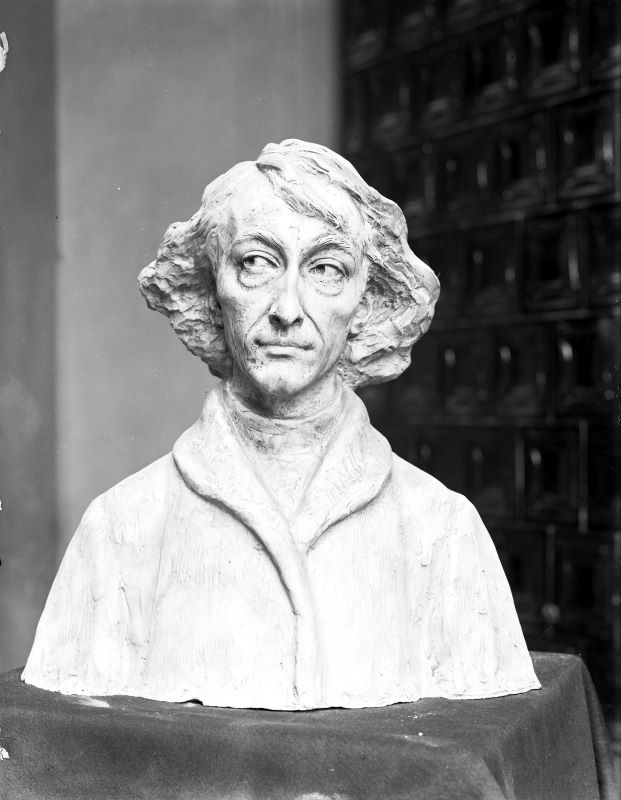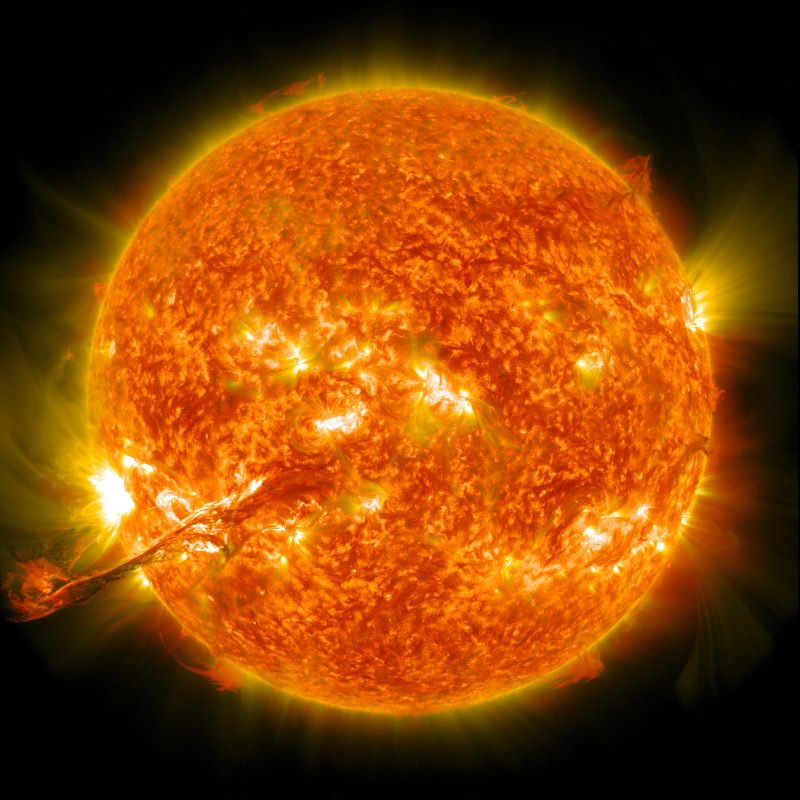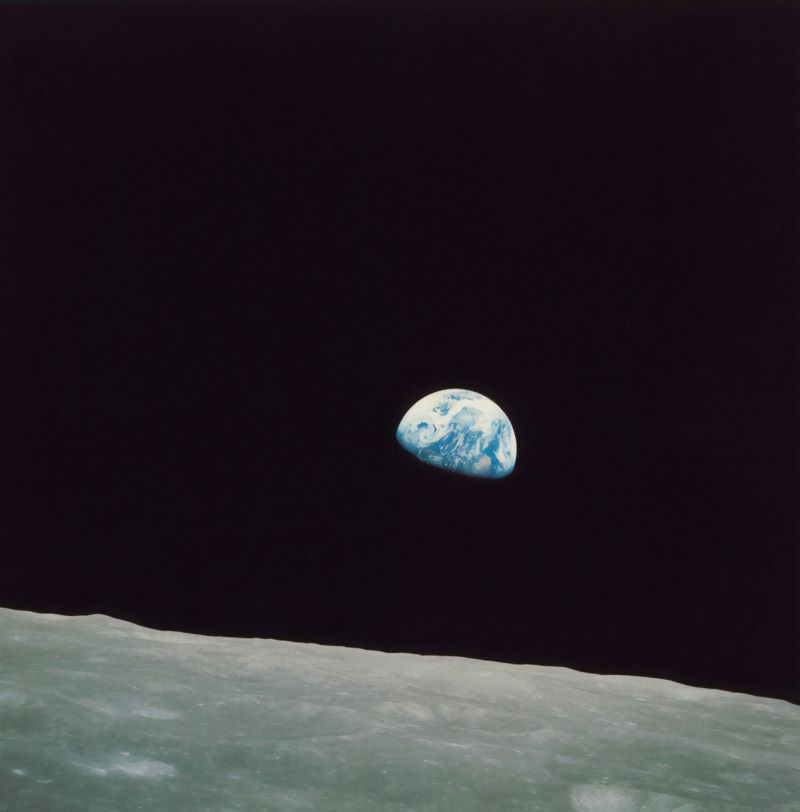A plaster sculpture by Konstanty Laszczka, depicting the bust of Nicolaus Copernicus | National Digital Archive
| Prof. Jan Sładkowski and Ilona Bednarek, PhD, DSc, Assoc. Prof. |
For almost 1,500 years, covering the last centuries of antiquity and almost the entire medieval period, we have been dealing with a stagnation in science, mainly due to the lack of sufficiently accurate measuring instruments. There was only a slight development in Arab astronomy in the 9th-11th centuries, consisting in increasing the accuracy of astronomical observations and in the calculation of planetary tables.
In the 16th century, the work of scientists such as Regiomontanus and Longomontanus marked the beginning of modern astronomy. However, the most important scientists of that period, who paved the way for the development of not only astronomy, but also other exact sciences, were Nicolaus Copernicus, Tycho Brahe, Johannes Kepler, Galileo Galilei and Isaac Newton. So, it all started with Copernicus, a versatilely educated person. Apart from mathematics and astronomy, he studied canon law and medicine (in Cracow and Bologna).
The birth of the heliocentric theory
Little is known about his childhood and youth. At the age of 10, after the death of his father, he and his brother Andrzej were able to continue their education thanks to the support of the influential uncle Łukasz Watzenrode, the bishop of Warmia. Nicolaus Copernicus considered himself a mathematician (at that time astronomy and music were a branch of mathematics), he also worked as a doctor (in one of the portraits he is depicted with a lily of the valley, a symbol of medics).
However, the most important work to which he devoted a large part of his life concerned the construction of a heliocentric model of the world. It was not a new idea. Similar theories appeared in ancient Greece. It is known that such a model was created by Aristarchus of Samos in the 3rd century BC, and it was supported by evidence by Seleucus of Seleucia.
Copernicus himself in the work of his life entitled ‘De revolutionibus orbium coelestium libri sex’, i.e. ‘Six Books Concerning the Revolutions of the Heavenly Orbs’, proposed the adoption of the heliocentric system as the model of the Universe, which at that time was limited to the solar system, and specifically: it did not go beyond the orbit of Saturn. Beyond was the realm of the fixed stars. Copernicus wrote about it as “the first and highest of all, which includes itself and everything, and therefore it is immobile, and is the background of the universe to which the movement and position of all other stars should be related”. The planets of the solar system, in order of increasing distance from the stationary Sun, are: Mercury, Venus, Earth with the Moon, Mars, Jupiter and the aforementioned Saturn.
Revolutionary ‘De revolutionibus’
The heliocentric model allowed for a less complicated, but not simple, explanation of the phenomena observed on the celestial sphere. According to Copernicus, most of the movements of celestial bodies are apparent movements that reflect two movements that the Earth performs – the rotation around its axis, explaining the rising and setting of stars, and the rotation around the Sun, explaining its apparent movement in the sky. On the other hand, the complicated motion of the planets against the background of the stars is the result of the superimposition of the actual motion of the planets and the motion of the Earth.
Although the heliocentric theory changed the image of the world, replacing the vision created by Aristotle, Copernicus was unable to completely cut himself off from the influence of ancient authorities, especially the aforementioned disciple of Plato. The astronomer accepted the view concerning the movement of celestial bodies, which, according to the ancient scientists, moved uniformly in a circle. However, it was necessary to explain the variable angular velocity of the apparent motion of the Sun and the planets. For this purpose, Copernicus assumed that the rotation of the Earth and the planets around the Sun takes place along eccentric circles the centres of which are not in the centre of the Sun. So it was not a heliocentric system in the literal sense of the word.
Copernicus is said to have “stopped the Earth and moved the Sun” | Photo by NASA from Unsplash
Adoption of such an assumption was not sufficient to explain the observed inconsistencies in the angular velocities of the Sun. The additional assumption was inevitable that the real revolutions of the planets take place in tiny epicycles with radii equal to 1/3 of the eccentricity of the planet’s orbit. Today, such complex periodic motions are described by the so-called Fourier series, but in antiquity and the Middle Ages it was a really brilliant idea.
A very important and new result obtained by Copernicus was the ability to compare the size of the orbits of the Earth and another planet. This means that although he did not know the size of the Earth’s orbit, he could give the size of the orbit of each planet, expressing it in terms of the Earth-Sun distance. In the Copernicus system, the radius of the Earth’s orbit was used for the first time as a unit for measuring the distance between the planets.
The beginnings of bold hypotheses
The polymath from Toruń presented a ground-breaking theory of the construction of the world in his work, but at this stage the revolutionary nature of his research ended. It can be said that the time for acceptance of the departure from the Platonic ideal of circular orbits had not yet come. All the more, it was not the moment to ask the question about the cause of the movement of the planets around the Sun.
In ‘De revolutionibus’, Copernicus also put forward a bold hypothesis about gravity: “At any rate, I believe that heaviness is nothing but a natural tendency, which the divine providence of the Creator of the universe gives to the parts only to make them unite and form a whole in the shape of a sphere. And it is trustworthy that such a tendency is also in the Sun, Moon and other luminous planets, so that by its operation they will continue in this roundness … “.
Relatively late and only at the insistence of friends, the astronomer published his work. It happened in 1543, the same year he died. This should not be surprising – the scientist was afraid of how his work would be received by both the Church and the scientific community. Moreover, he had no evidence to back up his claims. His theory was in direct contradiction to the more than 2,000-year-old geocentric view of the world. ‘De revolutionibus’ was created in a very restless, tense time of the Reformation, which undoubtedly affected the way in which Copernicus’s work was received.
A model that aroused a number of controversies
Initially, the Catholic Church did not oppose the heliocentric theory, moreover, in 1536 Cardinal Nikolaus von Schönberg wrote a letter from Rome in which he strongly urged the astronomer to disseminate his discovery as soon as possible! Problems with the Roman Church began later, when the ideas of heliocentrism became more widespread among scholars and began to exert an increasing influence on the views of people of the time. An important role in this was played by the intrigues of scientists envious of Galileo’s achievements and fame.
From the very beginning, Protestant theologians took a decidedly negative stance towards the heliocentric theory, pointing to its inconsistency with the Holy Scriptures, presenting theological and biblical arguments. Martin Luther and Philip Melanchthon sharply criticised Copernicus’s theory.
The heliocentric theory overthrew the paradigm that the Earth is at the centre of the universe. Here is a picture of our planet as seen from the Moon, taken during the Apollo 8 mission | Photo by The New York Public Library from Unsplash
Protestant scholars took a similar stance, among whom mention should be made of Kaspar Peucer, Teodoric or Tychon Brahe, the last of whom discovered the incompatibilities of the Toruń scientist’s model with the observations and proposed his own geo-heliocentric system (the Earth was in the centre, the Moon and the Sun revolved around it, and the other planets revolved around the sun and with it around the earth).
It should also be emphasised that the heliocentric system was rejected by Francis Bacon, one of the most outstanding modern philosophers. It was only Johannes Kepler who, using the exact observational data of Tycho Brahe and rejecting the circularity of the orbits, presented the correct model of the solar system. He did not accept the fact that in Copernicus’s system the centre of the world was a mathematical point (the assumption of circular orbits forced Copernicus to place their centres outside the Sun).
Prof. Jerzy Mioduszewski sums it up as follows: “Copernicus was one of the giants who brought science to its later heights. But when this was done, its spheres and their revolutions turned out to be unnecessary. They were discarded as a chrysalis discards its unnecessary shell, forgetting about it as a mature butterfly. A similarly tragic victor has perhaps been Aristotle, on whose system physics was built, which, once built, seemed to be the complete opposite of it”.
More details on the Copernicus model can be found in the following sources:
- Mioduszewski J., “Mikołaj Kopernik (1473–1543) – matematyk” [Nicolaus Copernicus (1473–1543) – mathematician], in: “Matematyka” [Mathematics] (1996) No. 3, 131–139.
- Wróblewski A.K., “Historia fizyki” [The history of physics]. PWN, 2011.
- Kolb R., “Ślepi obserwatorzy nieba” [Blind observers of the sky]. Prószyński i S-ka, 2006.
- Gingerich O., “Książka, której nikt nie przeczytał” [The Book Nobody Read]. Wydawnictwo Amber, 2004.
- Wierzbiński S., „Wstęp do astronomii matematycznej” [Introduction to mathematical astronomy]. Księgarnia Akademicka, 1950.








